May 12th, 2014 §
Last week most of my car trips included a chirping cardboard box riding shotgun. I delivered the chicks, which hatched in March, to their new owners. The little black pullet went to an acquaintance, a Wheaten Ameraucana pullet found a new and loving home with one of my Master Gardener friends, and the four Wheaten Ameraucana cockerels sold on CraigsList within an hour. Isn’t he handsome?

I kept two pullets. One is a pure Wheaten Ameraucana (in front below) and the other is a mystery hatched from a green egg out of a black mother! I love chickens at this age—about ten weeks—because they are sweet and curious, fully feathered but still small enough to pick up with one hand. They’re like little mini chicken pocket pets.
During the day I take the pullets out of their broody coop in the garage and put them in Tucker’s old puppy crate on the grass, and they eat their fill of clover, chickweed, whatever unfortunate bug comes along, and any grubs I unearth while digging in the garden. Last night they got to try pear for the first time.
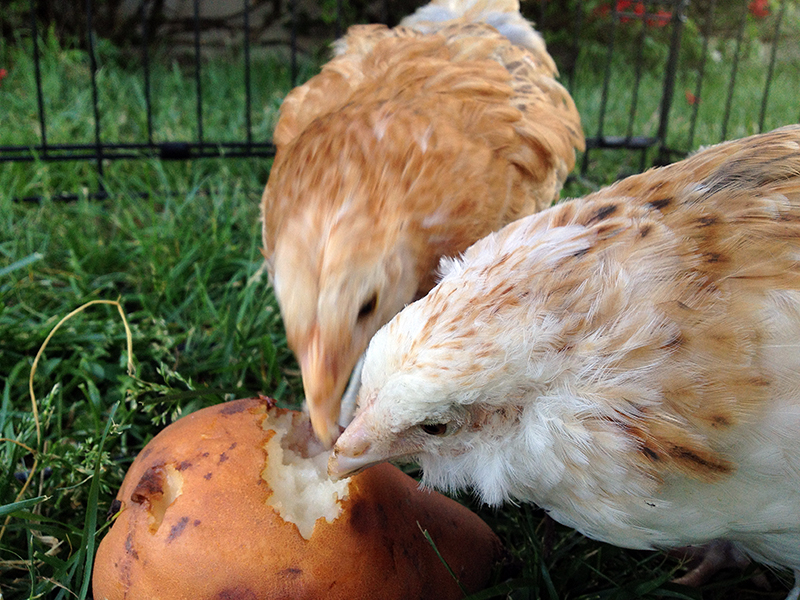

I am a bit sad that chick season is drawing to a close. If I could, I’d raise chickens all year long. I don’t think I will ever get tired of watching eggs turn into bright-eyed, beautiful birds.
Speaking of which, Mr. and Mrs. Bluebird are busy with their brood of four in the bluebird box. It’s wonderful to be back in bluebird season.

And finally, on a less joyful note, the feisty broody hen that hatched this latest batch of chicks wasn’t feisty enough when I returned her to the main flock. Despite holding her own for two days, on the eve of her third day back I found her with a quarter-size hole torn in the back of her skull. In her pain and panic to get away from her attackers she actually jumped into my arms from the nesting box. It’s the exact same wound Oregano sustained under similar circumstances, though this hen’s is worse.
She’s been getting daily Bactine spray and Neosporin plus Blue-Kote spray (which dyes her wound purple). I wish that I would have stitched her wound when I found it. She keeps knocking it open and it’s taking a very long time to heal, having to close from the outside in across basically her entire skull. In fact it’s larger now than it is in this photo, which I took a couple of weeks ago.

She doesn’t act hurt and has returned to laying eggs. As long as her wound doesn’t get infected I will just keep what I am doing and let it heal itself. My experience with Cora taught me that chickens can recover from the most dramatic wounds. This little hen is protected within another dog crate within the main coop, and will be until she heals and can successfully reintegrate with the flock.
This is what she gets for successfully raising the offspring of her sister flock mates. The injustice!
February 5th, 2013 §
One upside of attending to my Lavender Orpington’s wound on Sunday was that I discovered she had lice. And when I snagged Oregano, my barred olive egger, for inspection I saw that she too had a few creepy crawlies. It was time for an intervention.
With a healthy flock, regular dust bathing will keep most parasites at bay. But in winter, with its frozen or muddy ground, the birds aren’t able to dust bathe as much as in the warmer seasons. This gives lice a chance to populate the birds. If unchecked, these blood-sucking parasites will deplete a bird to the point where it dies.
Thankfully my flock was no where near that stage. Yet, after spending a night researching various treatments I decided to go straight for the chemical intervention and not waste my time with more “natural” or “organic” methods. I really wanted to nip this infestation in the bud, particularly as it’s still winter and the birds need all the energy they produce just to keep warm and regrow the feathers they’ve lost. And, in another few weeks (if I can get Iris to go broody again) I’d like to try hatching some eggs, which means all my birds should be as healthy as possible and louse-free to avoid passing the bugs on to more-vulnerable chicks.
So I picked up a can of poultry dust, which is a permethrin-based formulation that you may have used for insects in your vegetable garden. I assembled my tools:

I also suited up in latex gloves and a dust mask. Well, the gloves were a joke because it took just one kick of a captured chicken to shred them. I went through five pairs through this process and still ended up covered in dust. If you’re concerned about skin contact, I’d suggest heavier gloves for this job. And, really, with all the flapping and wind I ended up covered with this dust so if you are truly concerned it may not be the treatment for you to use.
Cora, the Wheaten Ameraucana hen, was the first I caught in the coop. Following the advice of a YouTube video, I flipped her on her back. This seemed to calm her enough that I could powder under her wings, a favorite parasite hiding spot. I held her upside down to work the powder in to the feathers under her vent, which is where I saw the lice in all my birds.

Lilac was up next.
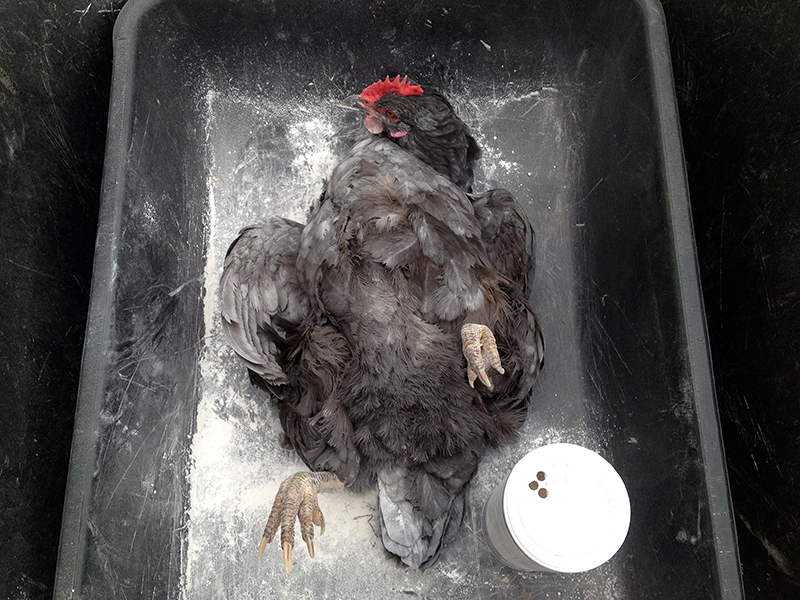
And so on through the flock. I left the injured Lavender until last so I could inspect her wound. It was open and bleeding, which I prefer to closed and infected, and seemed a tiny bit smaller than on Sunday.
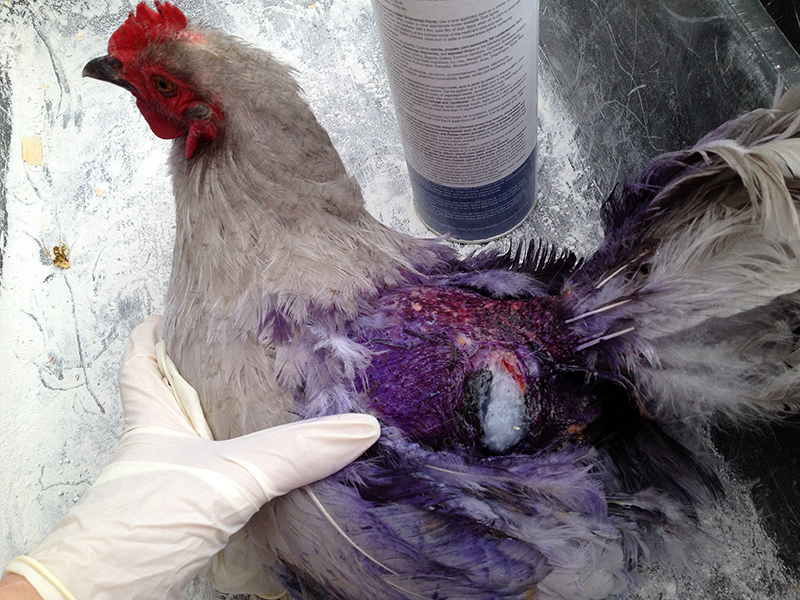
I packed it full of neosporin before dusting her.
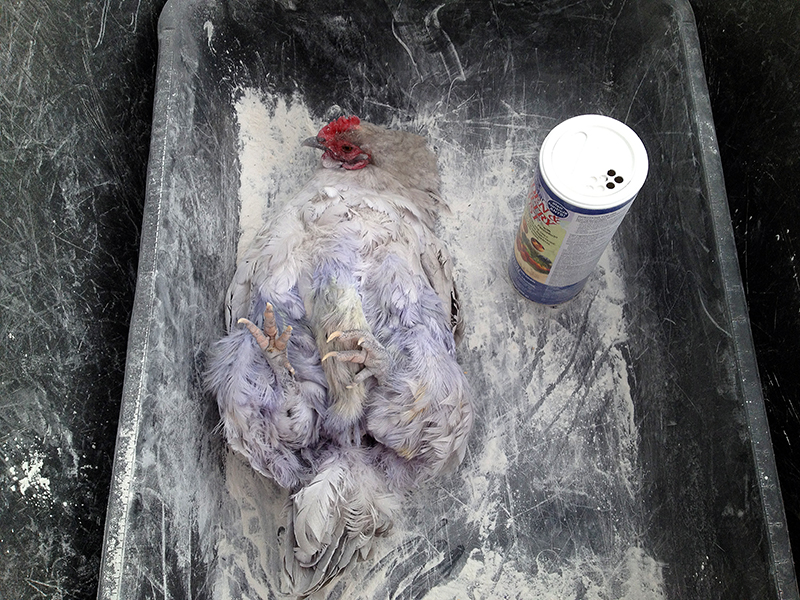
Now that’s a Lavender Orpington!
With the flock dusted, I did some housekeeping in the coop. I sprinkled food-grade diatomaceous earth in the nest boxes, in the chicken food, and filled a litter box with the stuff for dust-bathing in the coop. The diatomaceous earth, which is actually decomposed hard-shelled algae, acts in a mechanical manner (as opposed to chemical) on insects by slicing open their soft bodies, killing them.
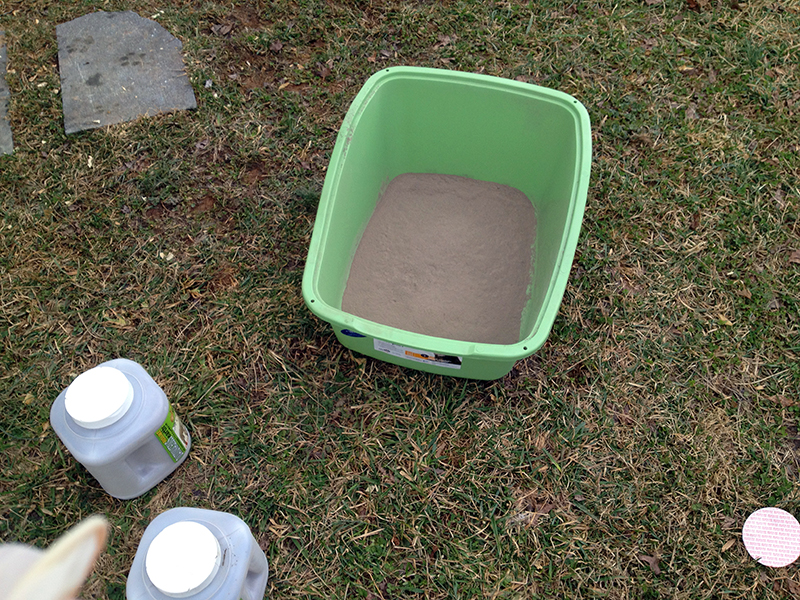
And with that the delousing procedure was complete. Now I get to look forward to ten days from now, when I repeat the powdering to kill any nits that will have hatched since today. Fun times!

February 3rd, 2013 §
If you are sickened by chicken wound pictures or first aid, this would be the post to skip.
This morning as I let the chickens out to range, I grabbed my smaller Lavender Orpington hen as she came out of the coop. I’d knew she had a wound for at least a couple of months, and I’d been watching it. I suspect that without feathers to protect her back, courtesy of my feather-picking hen, my rooster had sliced the Lavender’s back with his claws when he mounted her. What had been a small black hole was now a wound the size of a golf ball, hidden behind her wing.

Today, for the first time, the wound smelled bad. And when I flipped the hen over, I found a messy bottom and some sort of infestation in the fluffy feathers under her vent.
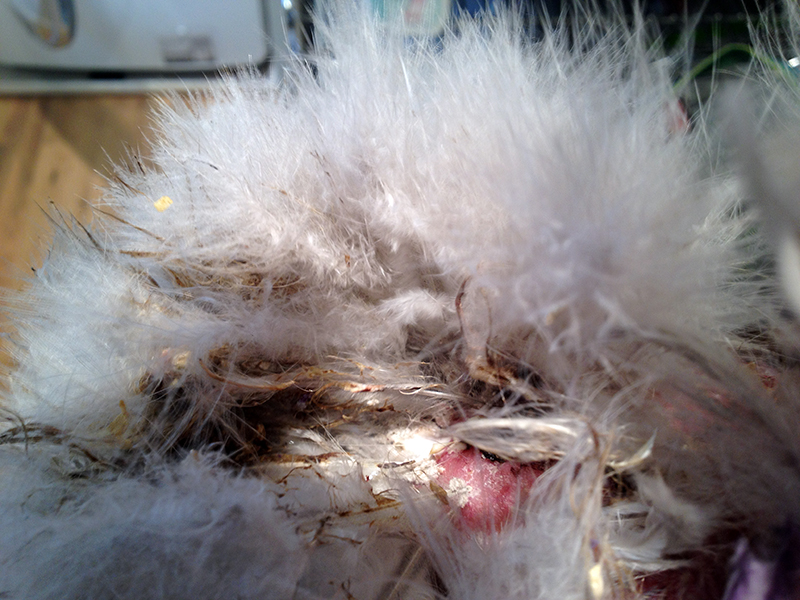
With her missing back feathers, purple Blu-Kote stains, a huge necrotic wound, and some sort of insect problem, this chick was a mess.
The evidence for culling her mounted as I considered her performance. This hen wasn’t a great layer, always depositing smallish eggs on the coop floor where they usually grew dirty enough that I fed them right to my dog. I’d made up my mind I didn’t want to continue to keep Lavender Orpingtons because I found their super-fluffy butt feathers to be always collecting poop and debris. And if she hadn’t managed to heal her back wound, did I really want to continue her genetics in my barnyard mix?
But what started as a snowy day had turned sunny, so I returned the hen to the flock for one last day of free ranging before I did the deed. And in the ensuing hours I thought about how I would. I had settled on beheading by branch lopper when I went out around noon to give the chickens the goodies in the compost bucket. When they saw me they all came running, including Dead Hen Walking. When I shook the compost around the garden, she was just as active as the other birds. I stood watching her for a long time, and when my feet finally grew too cold to stay outside any longer I had decided to put some effort into healing this bird.
With eight laying hens, two of which aren’t very stellar in their production rate, this Lavender’s dirty eggs represented a big percentage of my flock’s output. And I’d recently decided to free range my birds as much as possible, and thus some of her value lies in her insect control ability and manure production. Plus, I am fully expecting some predator loss during ranging. After considering the time and expense and food and care that I’ve put in to this bird since I got her in June, to get her grown and laying, it seemed foolish to cull her if she was still up and about and acting fine—even though the last thing I wanted to do was nurse another chicken.
But nurse her I did. I caught her and brought her into the surgery, my laundry room sink. I filled her back wound with peroxide while I soaked her dirty bum feathers in warm water. I scrubbed her clean with dog shampoo and then used needle-nosed pliers to remove the feathers that were caked with the eggs sacs of what I later found out were chicken lice. Underneath her plucked feathers she looked very much like the start of a supermarket dinner. When her back wound had softened I scrubbed it out with a disinfected toothbrush, loosening the blackened tissue and rinsing it down the drain. Then I alternated rinsing peroxide and providone iodine in the wound.
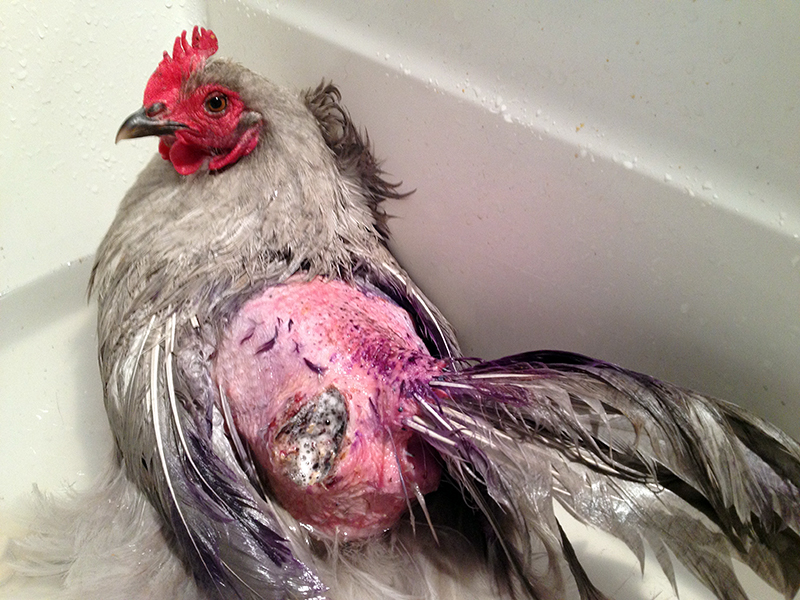
And through what must have been a horribly painful event, this blessed little hen put up nary a struggle. I’ve found my Lavender Orpingtons to be the sweetest, slowest, and most docile of all the breeds I keep, and her demeanor definitely showed through this treatment. She even seemed to enjoy the warm water soak.
When I had her cleaned up as best as I could, I got the hair dryer and blew her dry. I didn’t want her to get chilled when I returned her to the coop, and she bore this treatment with good graces that none of my other pets possess.
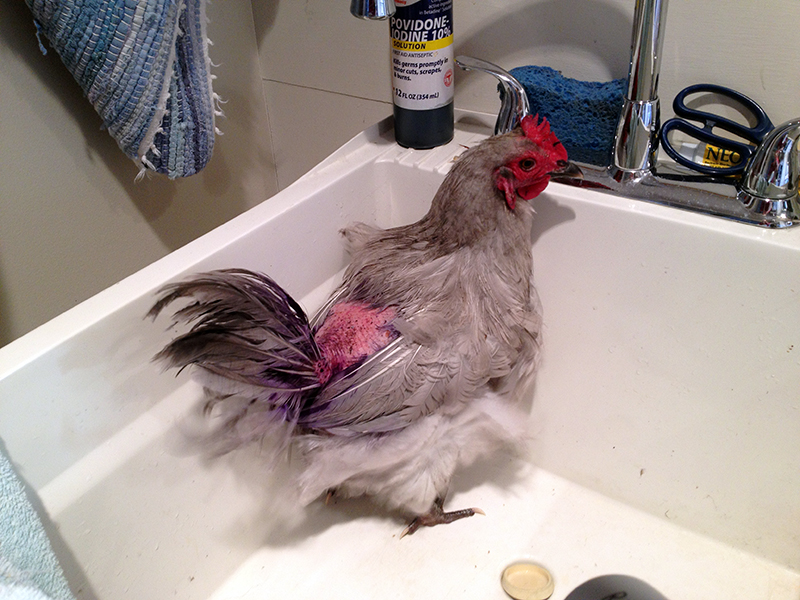
I worked on her until she began to smell of rotisserie, and then squirted even more iodine into her wound. Then I wrapped her in a towel and took her outside.

There she got a good spray of Blu-Kote to discourage her flock mates from pecking her bleeding, reddened skin. Then I released her into the coop. And within one second my rooster jumped on her back to mate. That kind of pissed me off, so I knocked him away and left them to their lives.
I don’t know if I will be able to get this hen’s back wound to heal, but I will keep trying. If Cora taught me anything it’s that chickens are incredibly resilient. Tomorrow I am going to get some diatomaceous earth and create a dusting box for the birds. Apparently chicken lice populations bloom in winter when the birds can’t dust bathe because of frozen or muddy ground. So I will start as conservatively as possible to treat the lice, keep an eye on the Lavender hen, continue allowing the birds out to free range as much as possible, and dream of spring.

















